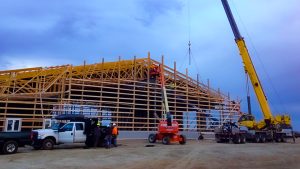What makes a healthcare construction project successful? What are the factors that should be considered in the beginning of the process to ensure a successful outcome when the building is complete?
Healthcare construction is a field that has seen many changes in the past few decades. The advancements in technology, changing needs of society and other factors have created an environment where the demand for healthcare services has increased while the process of constructing these facilities has become more complex. The COVID-19 pandemic has caused even further changes and challenges to overcome during the construction process as well. As a result, it is important for any healthcare construction company to understand the latest trends and best practices in this industry.
Getting Started
A successful construction project starts with a detailed knowledge of what it will take to complete the project successfully. For healthcare construction projects, this means understanding the needs of the hospital or medical facility staff and patients, as well as meeting regulatory standards for health and safety.
Hire Experts and Invest in Technology for Healthcare Construction
Healthcare construction projects are complex projects that frequently involve many features, systems, and disciplines. Successful project management relies on effective planning and risk management. The project management approach should be based on the fundamentals of the project scope, resources, budget, schedule, and quality. These fundamentals should be identified early during the planning and design phases and should then be refined and elaborated on during the construction phase.
Conduct a Preliminary Site Inspection and Complete the Budget
A preliminary site inspection is one of the first steps in a construction project, and is one of the most crucial. During this step you can check on permissions and site conditions, as well as ensure compliance with local authorities. Since there are so many moving parts in a construction project, doing routine inspections throughout the whole process is key to success.
Inspections also help to ensure your project is in compliance with the specification and quality requirements listed out in the contract. Specifications are detailed descriptions of construction methods, materials, and procedures. They specify how the project will be built and describe the components and manufacturing methods. Specifications also describe the type of soil, rock, and vegetation the site will encounter.
Finally, the budget review occurs before the construction contract is signed. During the preconstruction phase, the architect and contractor are gathering information and establishing internal cost estimates. Creating an accurate budget requires a thorough understanding of the project’s scope, schedule, and budget requirements, and much of that understanding comes from the preliminary site inspection.
Incorporate Integrated Project Delivery and Prepare
Integrated Project Delivery (IPD) combines the construction methods of traditional project management with the owner’s management philosophy. A construction project manager uses IPD to manage the contractor’s design and construction teams. Integrated Project Delivery focuses on managing the construction process, while traditional management focuses on managing the project. IPD places more responsibility on construction managers for construction and less time on owners for construction.
Safety Plans and Compliance with Government Regulations
Every project must comply with federal contract requirements, particularly construction safety requirements. Failure to comply with federal contract requirements can result in contract termination, monetary penalties, and/or legal sanctions.
Construction managers must negotiate a minefield of regulations and procedures to achieve a construction project. For example, the Occupational Safety and Health Act of 1970 requires employers in construction, manufacturing, and other industries to provide their employees with a safe environment. Employers must provide employees with an environment that allows them to work without exposure to hazards. Visit the Occupational Safety and Health Administration’s website to find more information on regulations within the construction industry to make sure you are properly prepared before beginning your project.
Measuring Success When Construction is Complete
Quantifying the success of a project depends on meeting different metrics in a variety of areas, from design and delivery to timeline and budget. Completion on time and within budget, meeting or exceeding the original design intent, and including features such as sustainable design, LEED certification, and fire safety are first steps in ensuring the favorable outcome necessary for the healthcare facility project. Ultimately, the incorporation of patient-centered care, features that are important to the community that will be using the facility, and the realization of financial sustainability will define success for the project.




